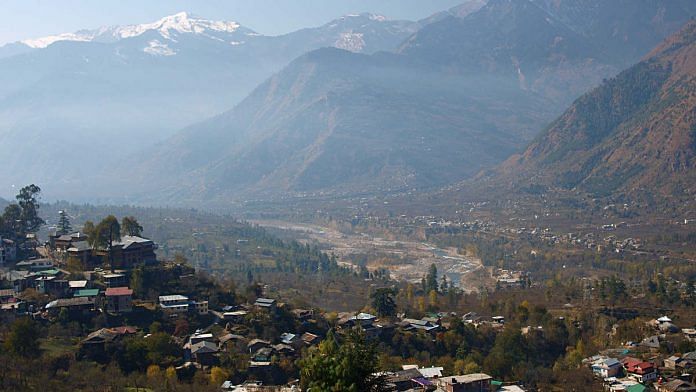New Delhi: The missing winter sting has caused apple orchards to shift uphill in the northern state of Himachal Pradesh, unpredictable rains force children to often skip schools, and some of the state’s temples that were once inaccessible due to snow now attract tourists — along with trash and pollution. These and many more changes have been compiled in short videos by a team of scientists from Indian Institute of Technology-Mandi and the Worcester Polytechnic Institute (WPI) in the US as part of their ‘Climate Stories Project’.
“There was a river here that had apple orchards along its banks. I used to pluck them earlier but these trees no longer bear fruit. Now apples are only found in the higher altitudes,” says a resident of the remote Chansari village in Kullu district in one video.
In the same clip, another resident says how mountains used to be “covered in snow till July” till about two decades ago.
The team of climate scientists has been documenting emotional and personal impact of climate change in people’s lives, including the receding snow-lines and shifts in the timing of seasons.
Ingrid Shockey, an associate teaching professor at WPI, believes stories rather than scientific data alone can help people understand the impact of climate change better.
“They can comprehend a story how someone’s life has changed over the years rather than by just looking at a trove of data. Stories are personal and we think they can bring about more change,” Shockey, a visiting faculty at IIT Mandi, told ThePrint.
Through the project, the team aims to also show how sharing these narratives can inform policies to tackle climate change. The project originated in New Zealand and went on to develop in India, Iceland and Japan. It will continue to document stories of ordinary people in locations around the world — their experiences both at personal lever and as a community.
Also read: People make it so hard to ditch plastic straws
Recording stories
The month of June in 2019 was the hottest in about 140 years of global record keeping, according to the US National Oceanic and Atmospheric Administration (NOAA).
The data showed that southern parts of India experienced record warmest temperatures in June, while most other parts were hotter than average.
Globally, temperature across land and ocean surfaces in June was 1.71°F above the 20th century average of 59.9°F. It was the highest on record. June 2019 also beat the previous record set in 2016 by 0.04°F.
Shockey has been working with Kaustav Sarkar, an assistant professor at IIT Mandi, and a team of students who visit remote villages and talk to residents in order to understand changes that have taken place in the past few decades.
“We decided how it would be very interesting to go out and collect stories from residents about experiencing climate change in Himachal Pradesh. We know that there are a lot of remote Himalayan villages – but the voice of its residents are seldom heard in discussions surrounding climate change,” Shockey added.
“Most researchers study patterns of meteorological factors such as temperature and rainfall. They try to see how these factors are changing and identify extreme incidents purely on the basis of data without going to the ground,” Sarkar said.
“But in every policy-making process it is important to understand how climate change has actually affected people’s lives and their agricultural practices,” he added.
The researchers are creating short videos of their interviews with residents and uploading it on the climate project website. People can also directly share their own experiences on the site.
Vulnerable Himalayas
“We went to a village called Suda in Himachal Pradesh. One of the primary issues that residents there told us was receding snow-lines. Lesser snowfall has been affecting the agricultural community too,” said Brant Reymann, one of the team members from WPI.
“A lot of people with apple orchards recalled how the state’s cooler climate had led to greater yield in the past. The flowering season is late too,” added Reymann.
School teachers at Bagi village in Mandi also reported that winter rains have become so heavy that children are often forced to skip classes. In another village named Sedaal, a government initiative of planting trees to combat deforestation had in turn led to water scarcity. The pine trees began consuming water from the melting snow that otherwise is a source of water for the village.
“Climate change has also led to migration from villages, fragmentation of communities and loss of traditional practice systems. In addition to environmental impact, this also has a devastating effect on the social fabric of an area,” Shockey added.
Through their project the team also hopes to bridge the gap between government and its people. “The Himalayan arc is most sensitive to climate change in the world. Having this archive of stories is useful information for government policy and agencies that wants to make some changes,” Shockey said.
David Santamaria, another member of the WPI, said more people have now started coming to a temple near Prashar Lake in Mandi because the area no longer gets heavy snowfall. This has led to a pile-up of trash around the temple, the local priest had told the team.
Also read: New study shows hundreds of sharks and rays entangled in discarded fishing nets, ropes



